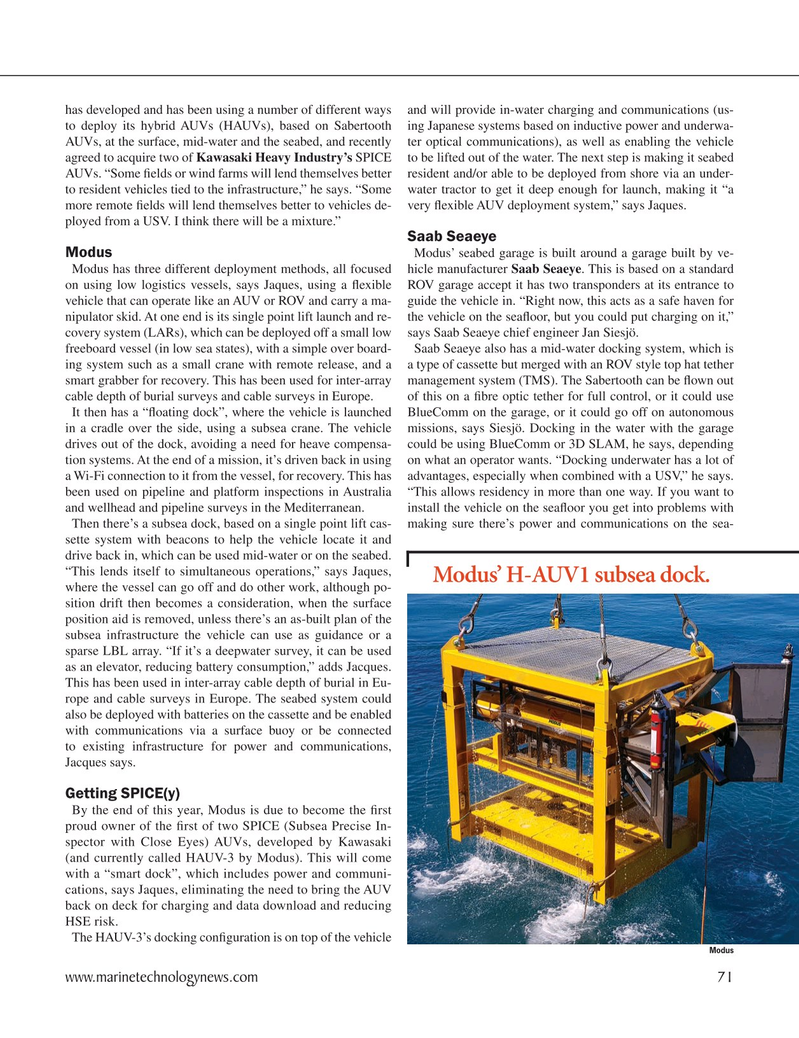
Page 71: of Marine Technology Magazine (September 2021)
MTR100: Focus on 100 Leading Companies, People and Innovations in the Subsea Space
Read this page in Pdf, Flash or Html5 edition of September 2021 Marine Technology Magazine
has developed and has been using a number of different ways and will provide in-water charging and communications (us- to deploy its hybrid AUVs (HAUVs), based on Sabertooth ing Japanese systems based on inductive power and underwa-
AUVs, at the surface, mid-water and the seabed, and recently ter optical communications), as well as enabling the vehicle agreed to acquire two of Kawasaki Heavy Industry’s SPICE to be lifted out of the water. The next step is making it seabed
AUVs. “Some ? elds or wind farms will lend themselves better resident and/or able to be deployed from shore via an under- to resident vehicles tied to the infrastructure,” he says. “Some water tractor to get it deep enough for launch, making it “a more remote ? elds will lend themselves better to vehicles de- very ? exible AUV deployment system,” says Jaques. ployed from a USV. I think there will be a mixture.”
Saab Seaeye
Modus Modus’ seabed garage is built around a garage built by ve-
Modus has three different deployment methods, all focused hicle manufacturer Saab Seaeye. This is based on a standard on using low logistics vessels, says Jaques, using a ? exible ROV garage accept it has two transponders at its entrance to vehicle that can operate like an AUV or ROV and carry a ma- guide the vehicle in. “Right now, this acts as a safe haven for nipulator skid. At one end is its single point lift launch and re- the vehicle on the sea? oor, but you could put charging on it,” covery system (LARs), which can be deployed off a small low says Saab Seaeye chief engineer Jan Siesjö. freeboard vessel (in low sea states), with a simple over board- Saab Seaeye also has a mid-water docking system, which is ing system such as a small crane with remote release, and a a type of cassette but merged with an ROV style top hat tether smart grabber for recovery. This has been used for inter-array management system (TMS). The Sabertooth can be ? own out cable depth of burial surveys and cable surveys in Europe. of this on a ? bre optic tether for full control, or it could use
It then has a “? oating dock”, where the vehicle is launched BlueComm on the garage, or it could go off on autonomous in a cradle over the side, using a subsea crane. The vehicle missions, says Siesjö. Docking in the water with the garage drives out of the dock, avoiding a need for heave compensa- could be using BlueComm or 3D SLAM, he says, depending tion systems. At the end of a mission, it’s driven back in using on what an operator wants. “Docking underwater has a lot of a Wi-Fi connection to it from the vessel, for recovery. This has advantages, especially when combined with a USV,” he says. been used on pipeline and platform inspections in Australia “This allows residency in more than one way. If you want to and wellhead and pipeline surveys in the Mediterranean. install the vehicle on the sea? oor you get into problems with
Then there’s a subsea dock, based on a single point lift cas- making sure there’s power and communications on the sea- sette system with beacons to help the vehicle locate it and drive back in, which can be used mid-water or on the seabed. “This lends itself to simultaneous operations,” says Jaques,
Modus’ H-AUV1 subsea dock. where the vessel can go off and do other work, although po- sition drift then becomes a consideration, when the surface position aid is removed, unless there’s an as-built plan of the subsea infrastructure the vehicle can use as guidance or a sparse LBL array. “If it’s a deepwater survey, it can be used as an elevator, reducing battery consumption,” adds Jacques.
This has been used in inter-array cable depth of burial in Eu- rope and cable surveys in Europe. The seabed system could also be deployed with batteries on the cassette and be enabled with communications via a surface buoy or be connected to existing infrastructure for power and communications,
Jacques says.
Getting SPICE(y)
By the end of this year, Modus is due to become the ? rst proud owner of the ? rst of two SPICE (Subsea Precise In- spector with Close Eyes) AUVs, developed by Kawasaki (and currently called HAUV-3 by Modus). This will come with a “smart dock”, which includes power and communi- cations, says Jaques, eliminating the need to bring the AUV back on deck for charging and data download and reducing
HSE risk.
The HAUV-3’s docking con? guration is on top of the vehicle
Modus www.marinetechnologynews.com 71
MTR #7 (66-79).indd 71 9/22/2021 10:02:03 AM

 70
70

 72
72
